Generous Container Displays
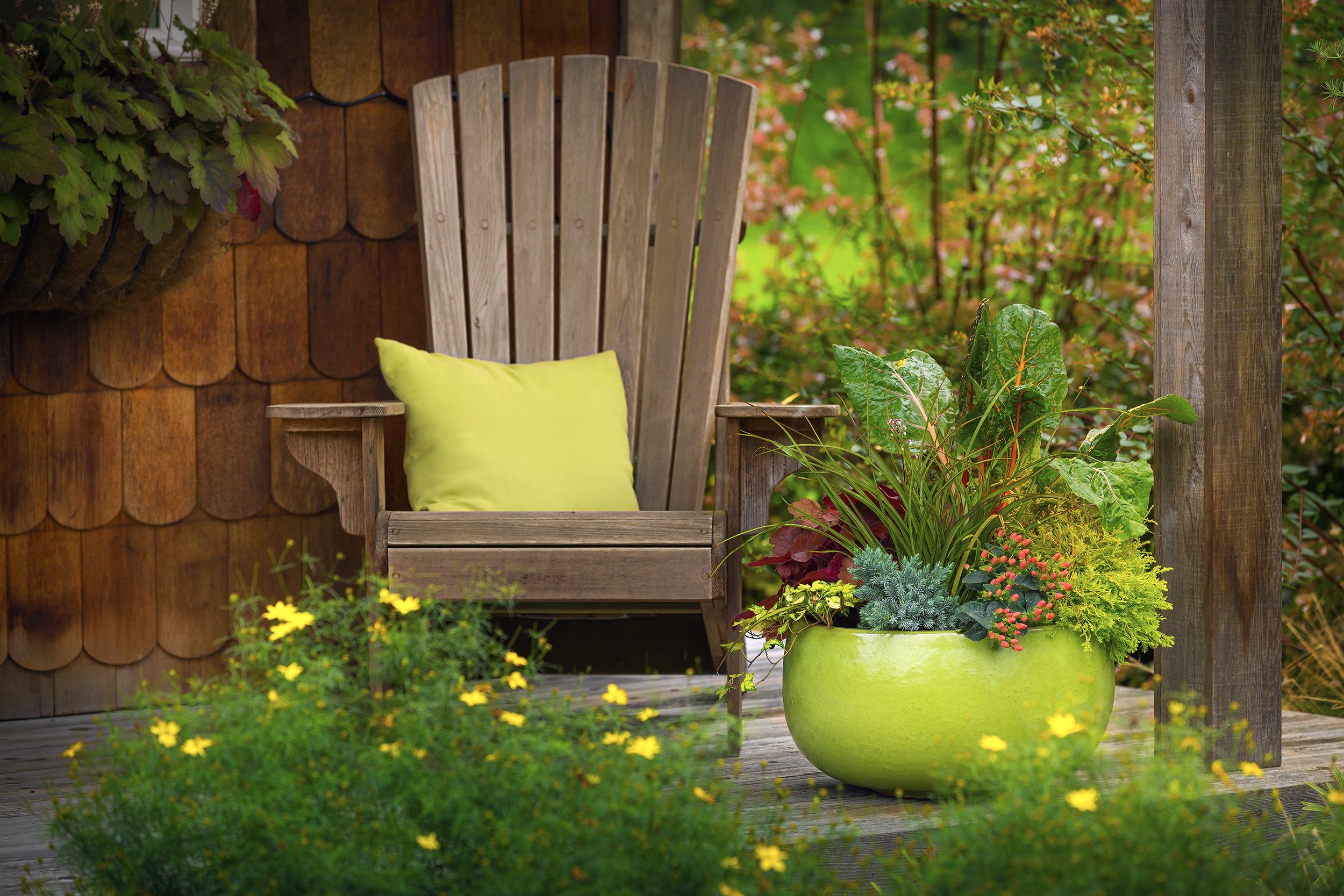
Flowers are the obvious fix when a garden needs color. But, as designer Karen Chapman learned decades ago, foliage plants often deliver a better show. Growing up in England, she’d always admired free-flowering cottage gardens and tried replicating the look early on, only to discover that blooms were disappointingly fleeting and maintenance was heavy. So, as a young designer, she shifted her approach: “I realized that I could still create a romantic, chocolate-box look if I simply built a strong leafy framework first.” Her designs are now decidedly foliage-driven, a style perfectly depicted in her own garden’s container displays, shown throughout this story.
Heavy on The Foliage

“I’m definitely not anti-flowers,” says Chapman, coauthor of Fine Foliage (St. Lynn’s Press, 2013). “But I use them as accents rather than main features.” She’s known for potting up unexpected groupings, where conifers mingle with succulents, edible greens stand beside dwarf trees, and houseplants get seated outdoors with shade-loving perennials. Whimsical arrangements too impractical for garden beds, due to spacing and growing constraints, become possible in containers that need last only one growing season. To accommodate the diversity, Chapman selectively hand-waters, giving less to drought-tolerant plants, and she blends her own potting mix, using an 80:20 ratio of bagged container soil (sans fertilizer or moisture-retention granules) to nutrient-rich compost.
Leaf-Inspired Grouping Designs
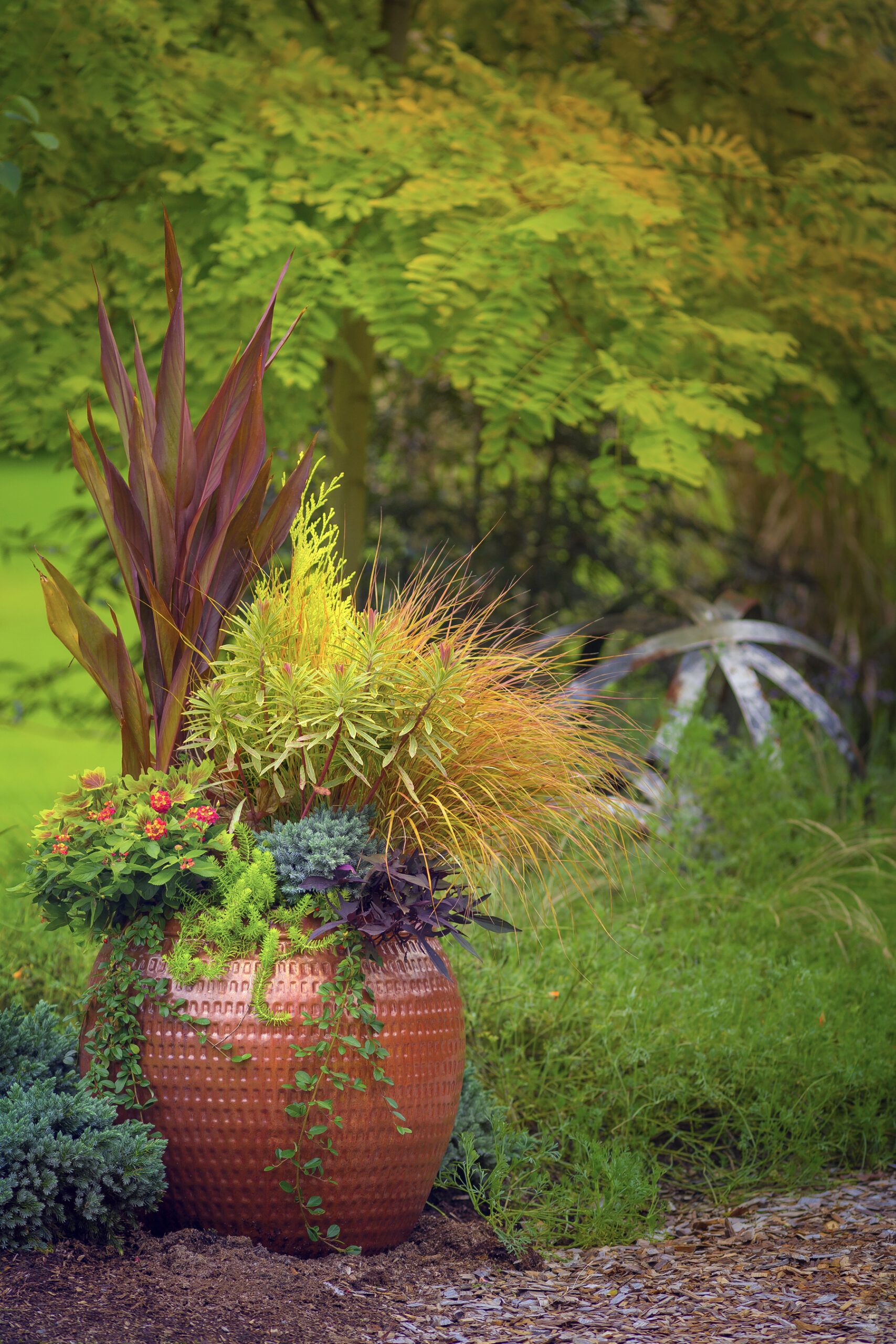
The pot itself often kicks off her color palette, while its style sets the theme. Then come the plants. Each design begins with one foliage plant. She strolls the nursery’s aisles until she spots a leaf with enough interest to inspire a design. And with this starting point in hand, she begins filling her cart with other leafy plants that share or nicely contrast with the initial pick’s coloring, texture, or shape. Flowers don’t come into play until she has a strong ensemble of coordinating leaves. “They’re the last piece of the puzzle,” she says. “The design should hold together without them.”
The containers on these slides showcase her technique. All are multiseason displays and easy-care, but they’re also big on texture and packed with plants, hinting at the designer’s English roots—even in the absence of flowers.
Edible Accent
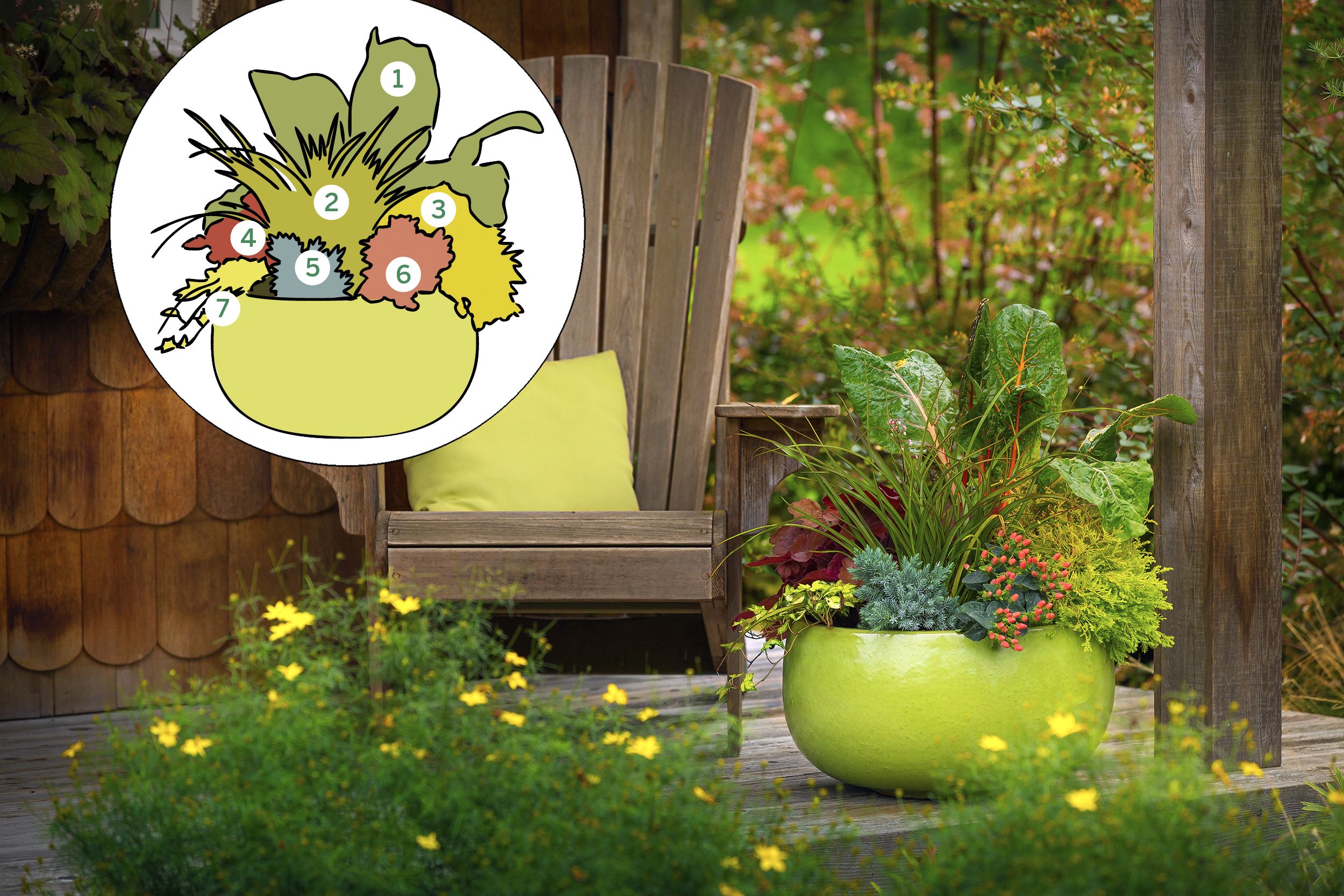
Seattle-based garden designer Karen Chapman is known for giving leaf color, shape, and texture the primary role in her container combinations. This flowerless mix of cheery limes and corals will look complete even after the orange-ribbed Swiss chard is harvested.
1. ‘Bright Lights’ Swiss chard (Beta vulgaris subsp. cicla)
2. ‘Tom Thumb’ New Zealand flax (Phormium tenax ‘Tom Thumb’)
3. ‘Rheingold’ arborvitae (Thuja occidentalis ‘Rheingold’)
4. ‘Fire Alarm’ coral bells (Heuchera ‘Fire Alarm’)
5. ‘Blue Star’ juniper (Juniperus squamata ‘Blue Star’)
6. ‘Hypearls Olivia’ St. John’s wort (Hypericum ‘Hypearls Olivia’)
7. ‘Variegata’ English ivy (Hedera helix ‘Variegata’)
Power of One
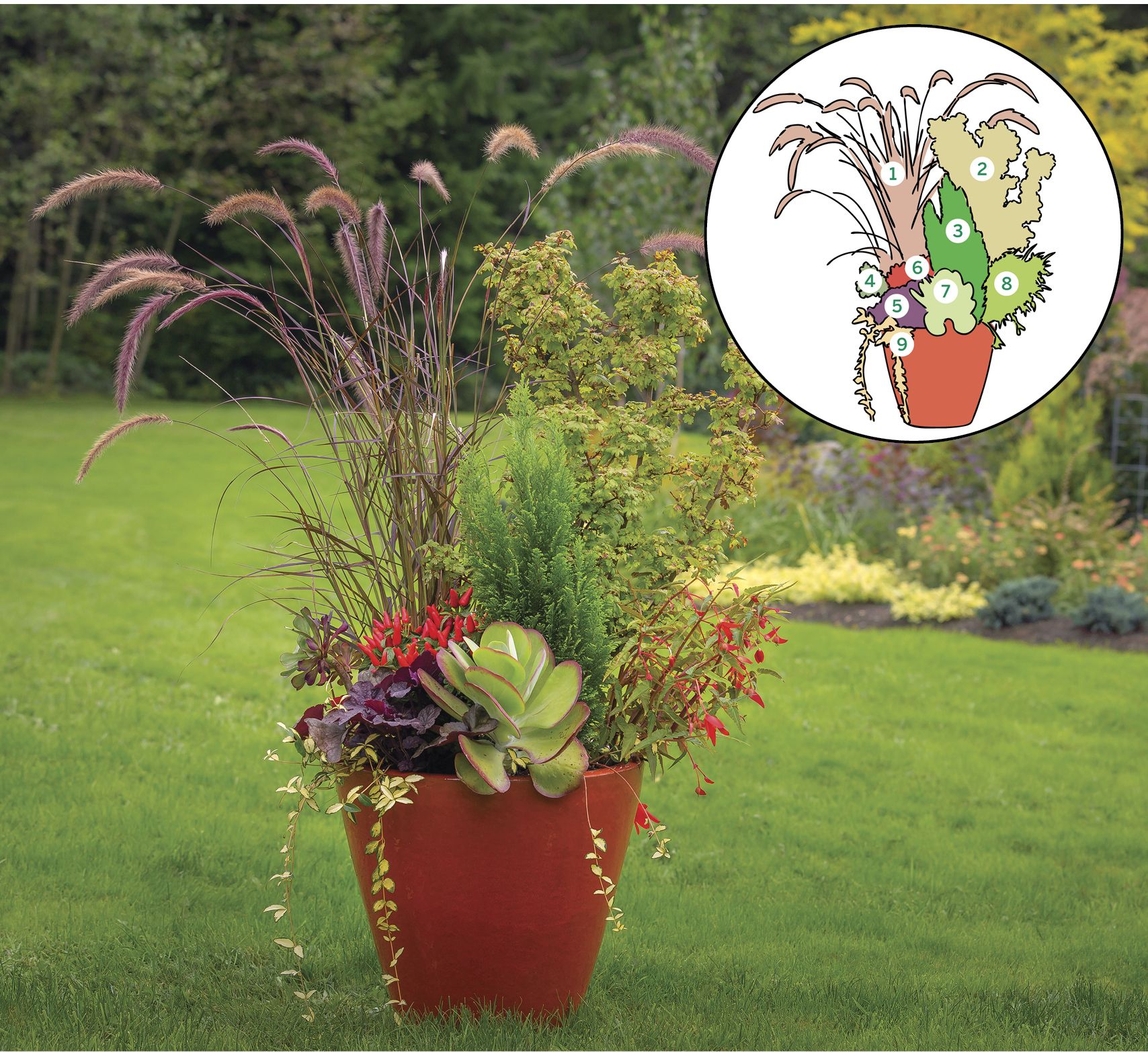
Red, in varying shades, knits this eclectic mix together. With three “thriller” plants and a riot of textures, the color palette had to stay simple.
1. Purple fountain grass (Pennisetum setaceum ‘Rubrum’)
2. ‘Little Gem’ vine maple (Acer circinatum ‘Little Gem’)
3. ‘Ellwood’s Empire’ Lawson false cypress (Chamaecyparis lawsoniana ‘Ellwood’s Empire’)
4. ‘Red Cauli’ stonecrop (Sedum telephium ‘Red Cauli’)
5. ‘Beaujolais’ coral bells (Heuchera villosa ‘Beaujolais’)
6. Ornamental pepper (Capsicum annuum)
7. ‘Desert Rose’ paddle plant (Kalanchoe thyrsiflora ‘Desert Rose’)
8.‘Waterfall Encanto Red’ begonia (Begonia ‘Waterfall Encanto Red’)
9. ‘Illumination’ periwinkle (Vinca minor ‘Illumination’)
Leafy Cornucopia
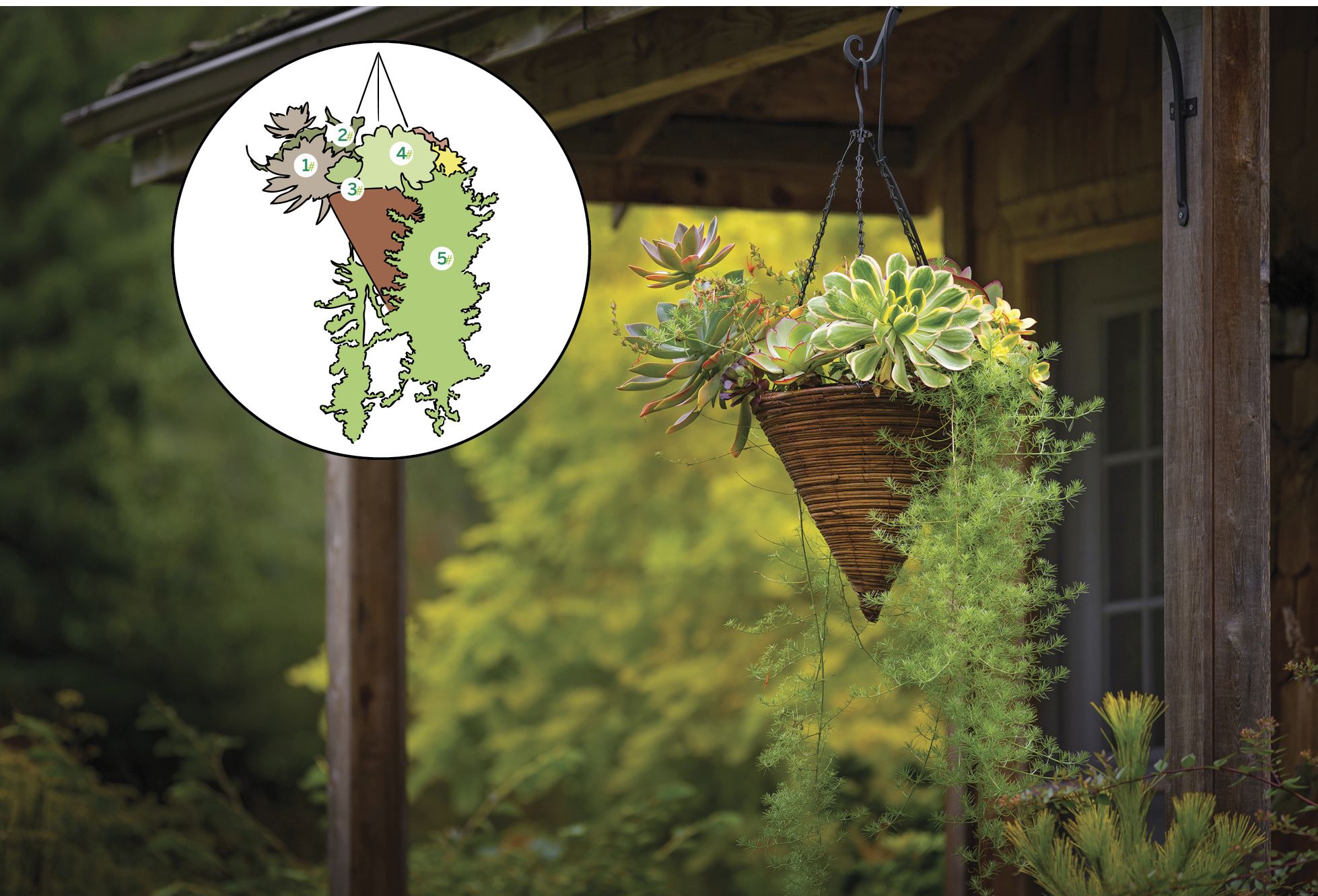
Mixing bold and fine foliage gives this mostly green hanging display just enough contrast.
1. ‘Fred Ives’ echeveria (Graptoveria ‘Fred Ives’)
2. ‘Apricot Sprite’ hyssop (Agastache ‘Apricot Sprite’)
3. Red edge echeveria (Echeveria subrigida)
4. ‘Sunburst’ aeonium (Aeonium decorum ‘Sunburst’)
5. Parrot’s beak (Lotus berthelotii)
Rule Breaker
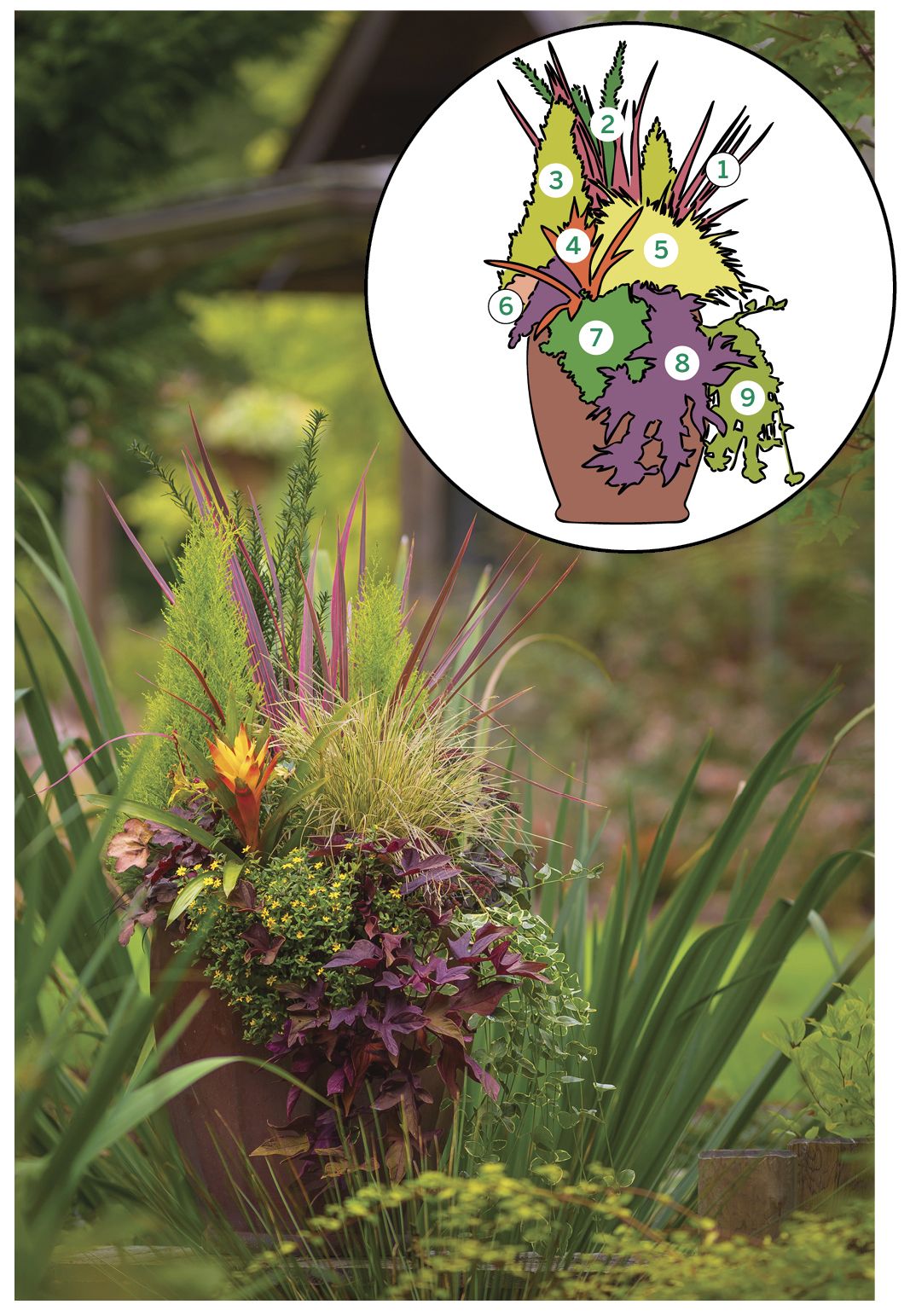
Going heavy on spiky leaves usually looks too busy. But here, dense conifers soften their jagged edges.
1. Electric Pink cordyline (Cordyline banksii ‘Sprilecpink’)
2. Irish yew (Taxus baccata ‘Fastigiata’)
3. ‘Goldcrest’ Monterey cypress (Cupressus macrocarpa ‘Goldcrest’)
4. Bromeliad (Bromeliad)
5. ‘Northern Lights’ tufted hair grass (Deschampsia cespitosa ‘Northern Lights’)
6. ‘Root Beer’ coral bells (Heuchera ‘Root Beer’)
7. Creeping zinnia (Sanvitalia procumbens)
8. ‘Sweet Caroline Red’ sweet potato vine (Ipomoea batatas ‘Sweet Caroline Red’)
9. Variegated vinca vine (Vinca major ‘Variegata’)
Starter Garden
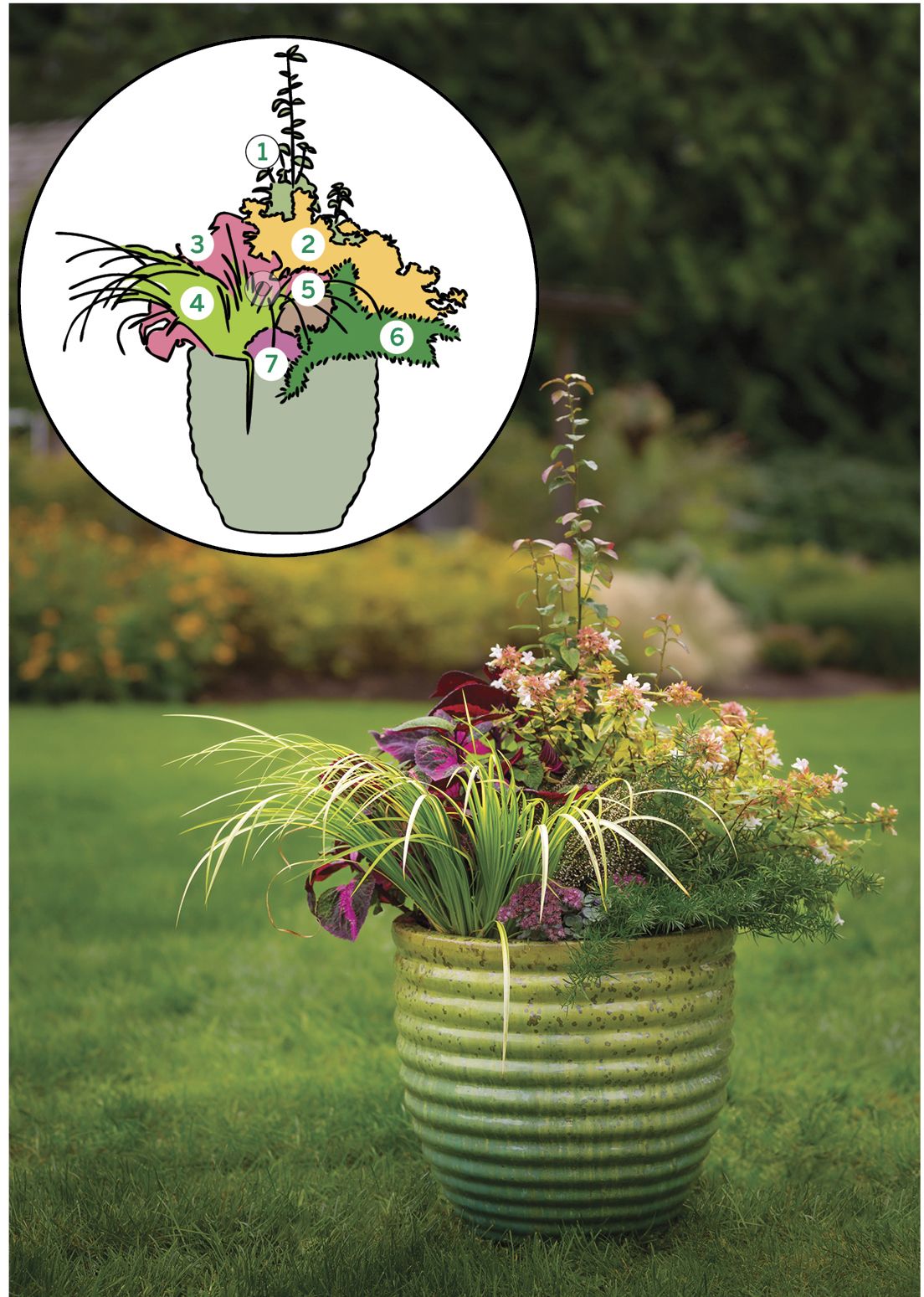
Using young trees and shrubs in containers lets you enjoy them while they’re small and affordable. The woody plants starring in this speckled sage pot will get a spot in a bed once they’re big enough to impress.
1. Persian Spire ironwood (Parrotia persica ‘JL Columnar’)
2. ‘Kaleidoscope’ abelia (Abelia x grandiflora ‘Kaleidoscope’)
3. ‘Magilla’ perilla (Perilla ‘Magilla’)
4. Golden variegated sweet flag (Acorus gramineus ‘Ogon’)
5. Heather (Calluna vulgaris)
6. ‘Sprengeri’ asparagus fern (Asparagus densiflorus ‘Sprengeri’)
7. October Daphne stonecrop (Sedum sieboldii)
Hot Hues
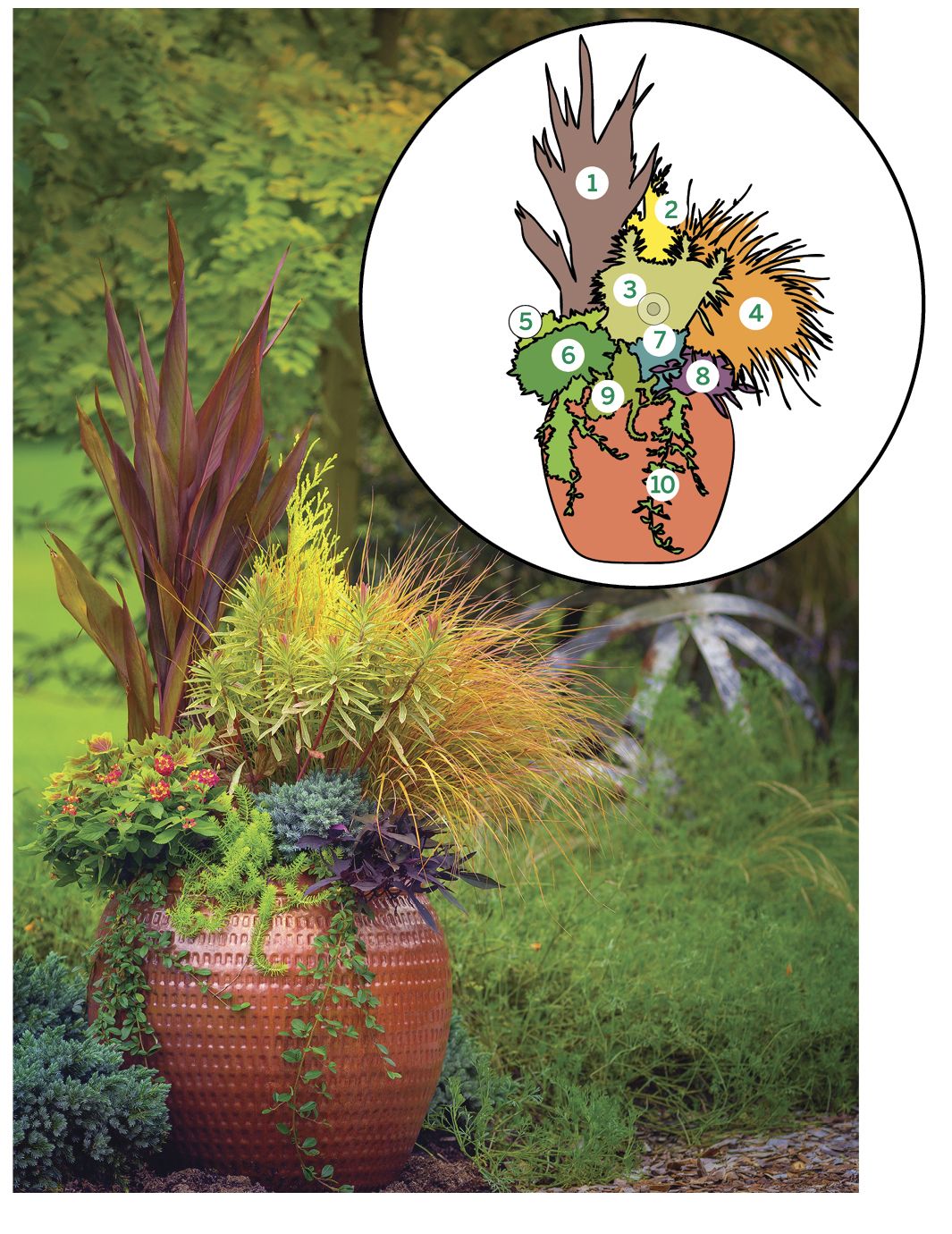
Punches of burgundy and burnt orange make this frilly display pop, while frosty-blue conifers anchor the container to the garden.
1. ‘Intrigue’ canna (Canna ‘Intrigue’)
2. Forever Goldy arborvitae (Thuja plicata ‘4ever’)3. ‘Ascot Rainbow’ spurge (Euphorbia x martinii ‘Ascot Rainbow’)
4. Pheasant’s tail grass (Stipa arundinacea)
5. ‘Vancouver Centennial’ geranium (Pelargonium x hortorum ‘Vancouver Centennial’)
6. Luscious Berry Blend lantana (Lantana camara ‘LAN 876’)
7. ‘Blue Star’ juniper (Juniperus squamata ‘Blue Star’)
8. ‘Blackie’ sweet potato vine (Ipomoea batatas ‘Blackie’)
9. ‘Angelina’ stonecrop (Sedum rupestre ‘Angelina’)
10. Bearberry cotoneaster (Cotoneaster dammeri)
Modern Topiary
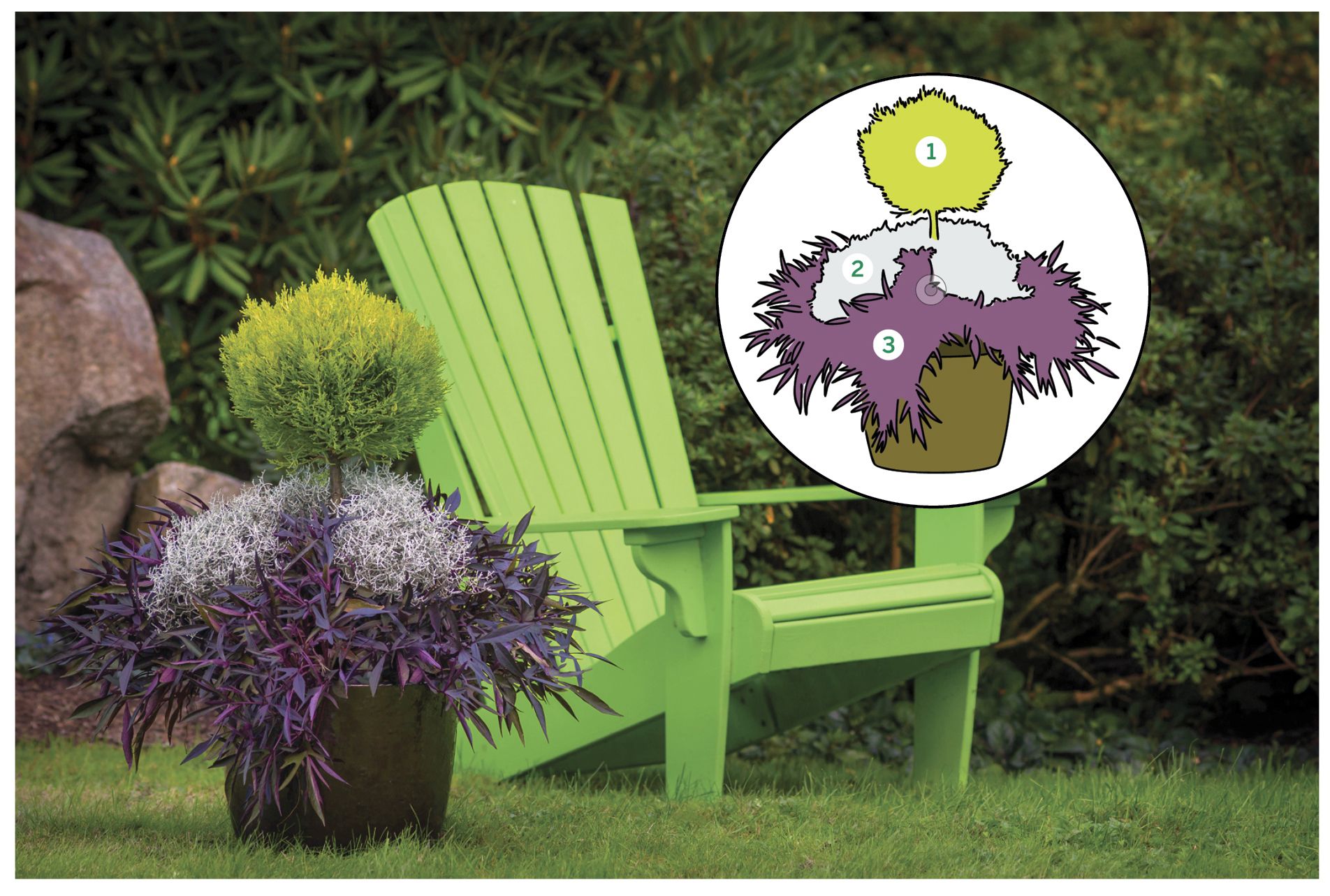
Staking tiers of delicate leaves in contrasting shades dresses down a formally sheared conifer.
1. ‘Goldcrest’ Monterey cypress (Cupressus macrocarpa ‘Goldcrest’)
2. Cushion bush (Leucophyta brownii)
3. Illusion Midnight Lace sweet potato vine (Ipomoea batatas ‘NCORNSP-011MNLC’)
Tall Order
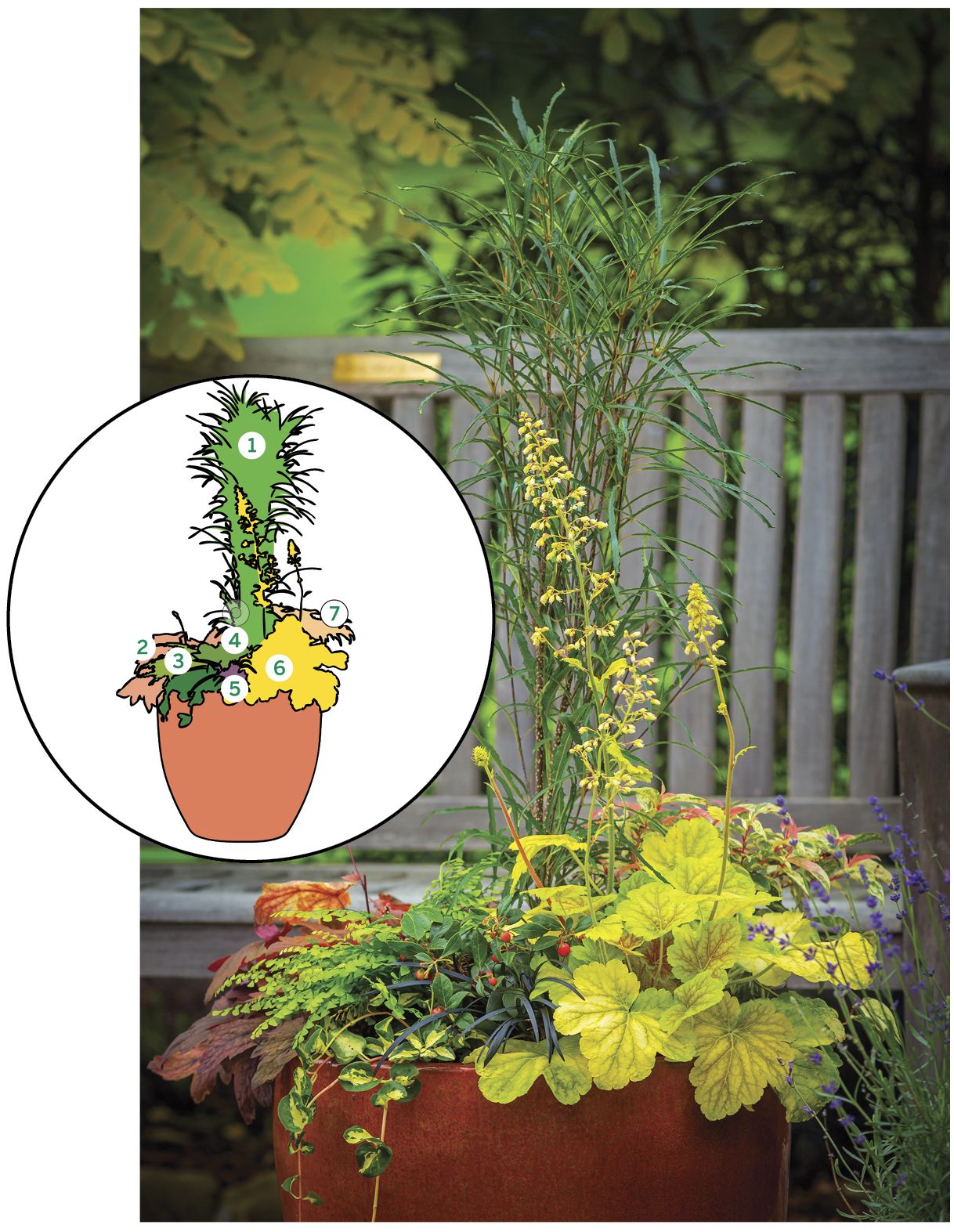
Propping up this planting almost to seat level makes the bright, variegated leaves easier to admire.
1. Fine Line buckthorn (Rhamnus frangula ‘Ron Williams’)
2. ‘Sweet Tea’ foamy bells (Heucherella ‘Sweet Tea’)
3. Himalayan maidenhair fern (Adiantum venustum)
4. Wintergreen (Gaultheria procumbens)
5. Black mondo grass (Ophiopogon planiscapus ‘Nigrescens’)
6. ‘Delta Dawn’ coral bells (Heuchera ‘Delta Dawn’)
7. ‘Rainbow’ fetterbush (Leucothoe fontanesiana ‘Rainbow’)
Deep-Hued Drama
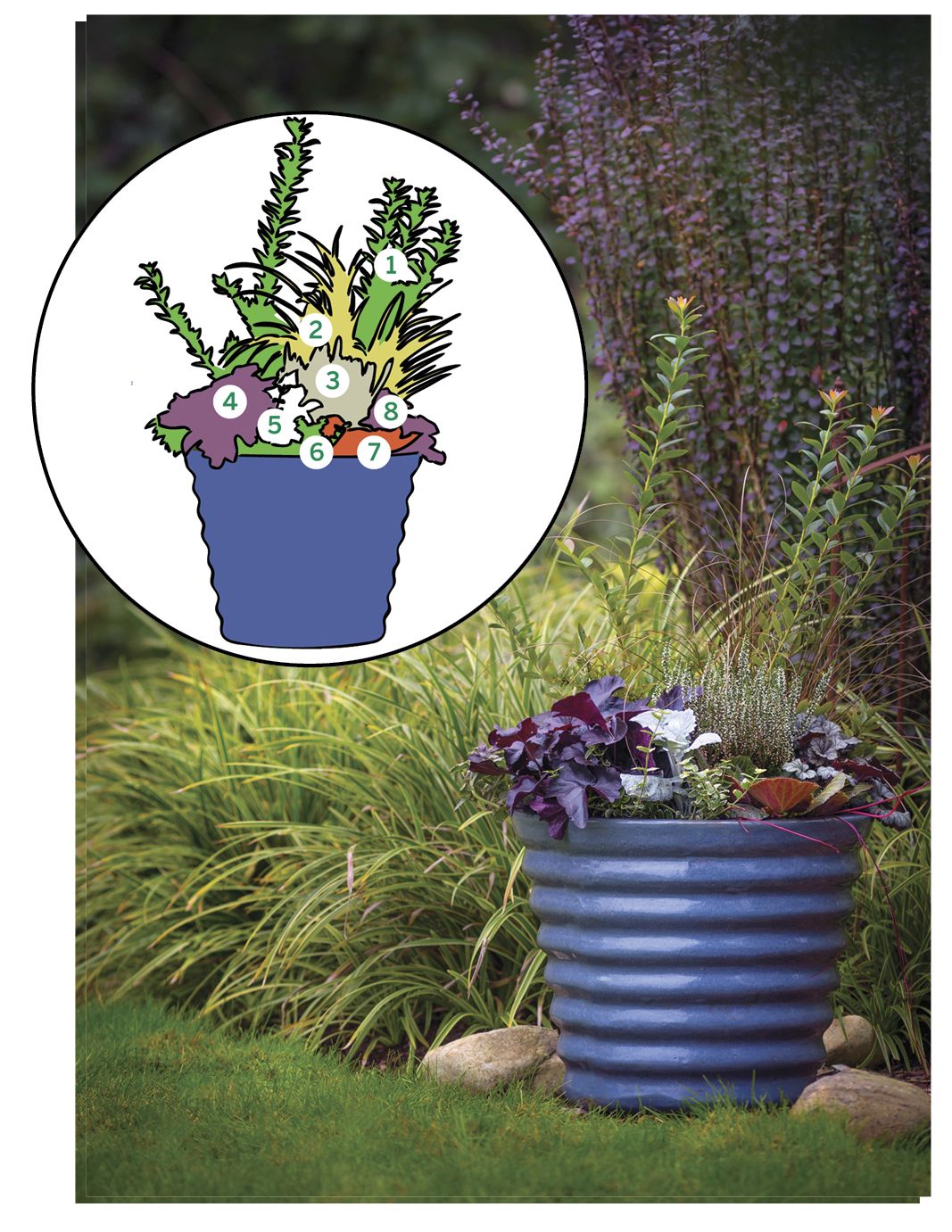
Picking up the burgundy hue of a nearby barberry shrub connects this cool-colored combo to its partly shaded border.
1. ‘Sunshine Blue’ blueberry (Vaccinium x ‘Sunshine Blue’)
2. ‘Toffee Twist’ sedge (Carex flagellifera ‘Toffee Twist’)
3. Heather (Calluna vulgaris)
4. ‘Obsidian’ coral bells (Heuchera x ‘Obsidian’)
5. ‘Cirrus’ dusty miller (Senecio cineraria ‘Cirrus’)
6. ‘Emerald Gaiety’ wintercreeper (Euonymus fortunei ‘Emerald Gaiety’)
7. Strawberry begonia (Saxifraga stolonifera ‘Maroon Beauty’)
8. ‘Rave On’ coral bells (Heuchera ‘Rave On’)
Shady Surprise
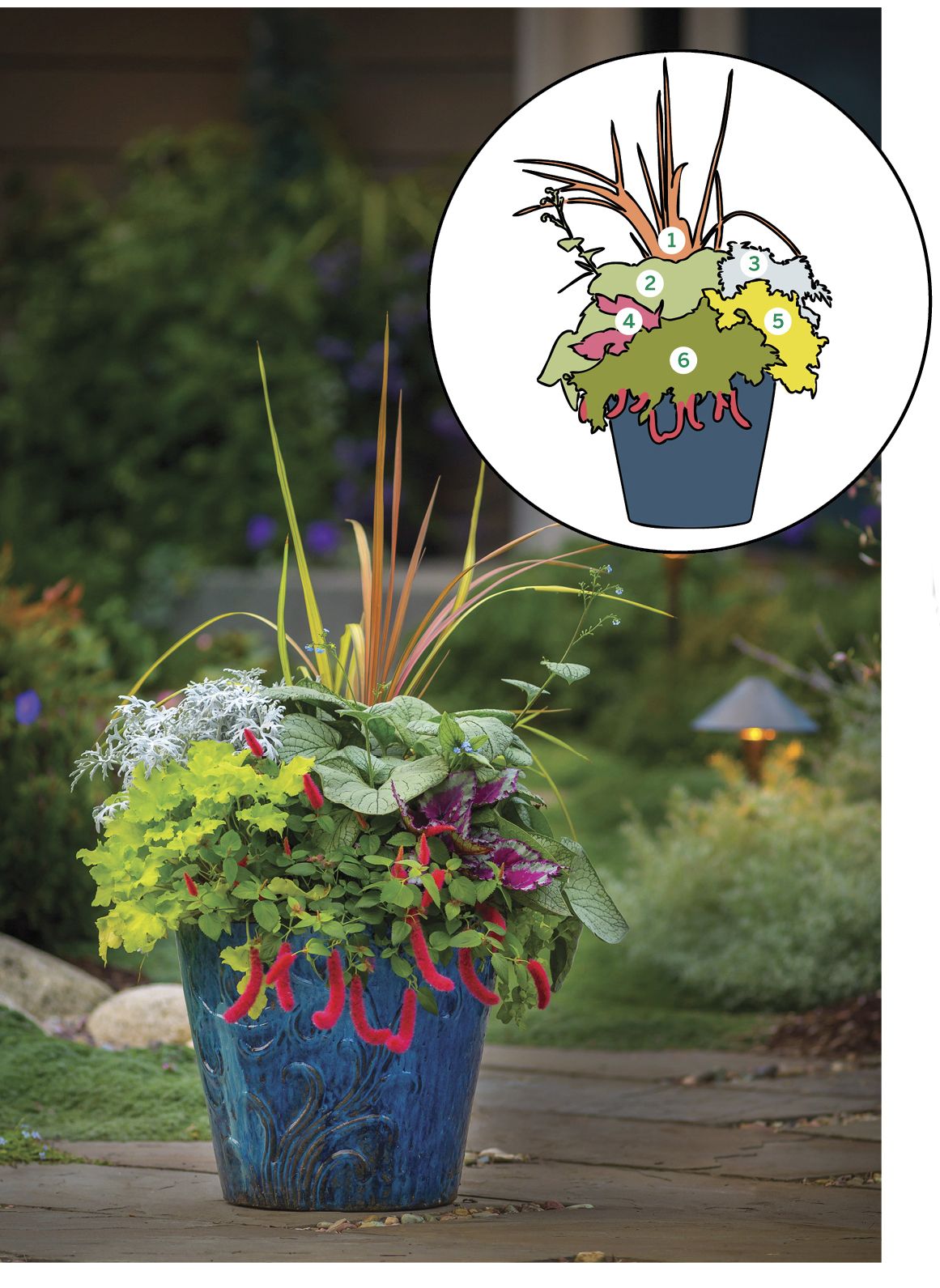
Using chenille plant, an old-fashioned houseplant with fuzzy red flowers, gives this patio pot a playful twist.
1. ‘Cha Cha’ cordyline (Cordyline ‘Cha Cha’)
2. ‘Silver Heart’ brunnera (Brunnera macrophylla ‘Silver Heart’)
3. ‘Silver Dust’ dusty miller (Senecio cineraria ‘Silver Dust’)
4. Rex begonia (Begonia rex)
5. ‘Lime Marmalade’ coral bells (Heuchera ‘Lime Marmalade’)
6. Chenille plant (Acalypha hispida)
Container Plant Formula for Success
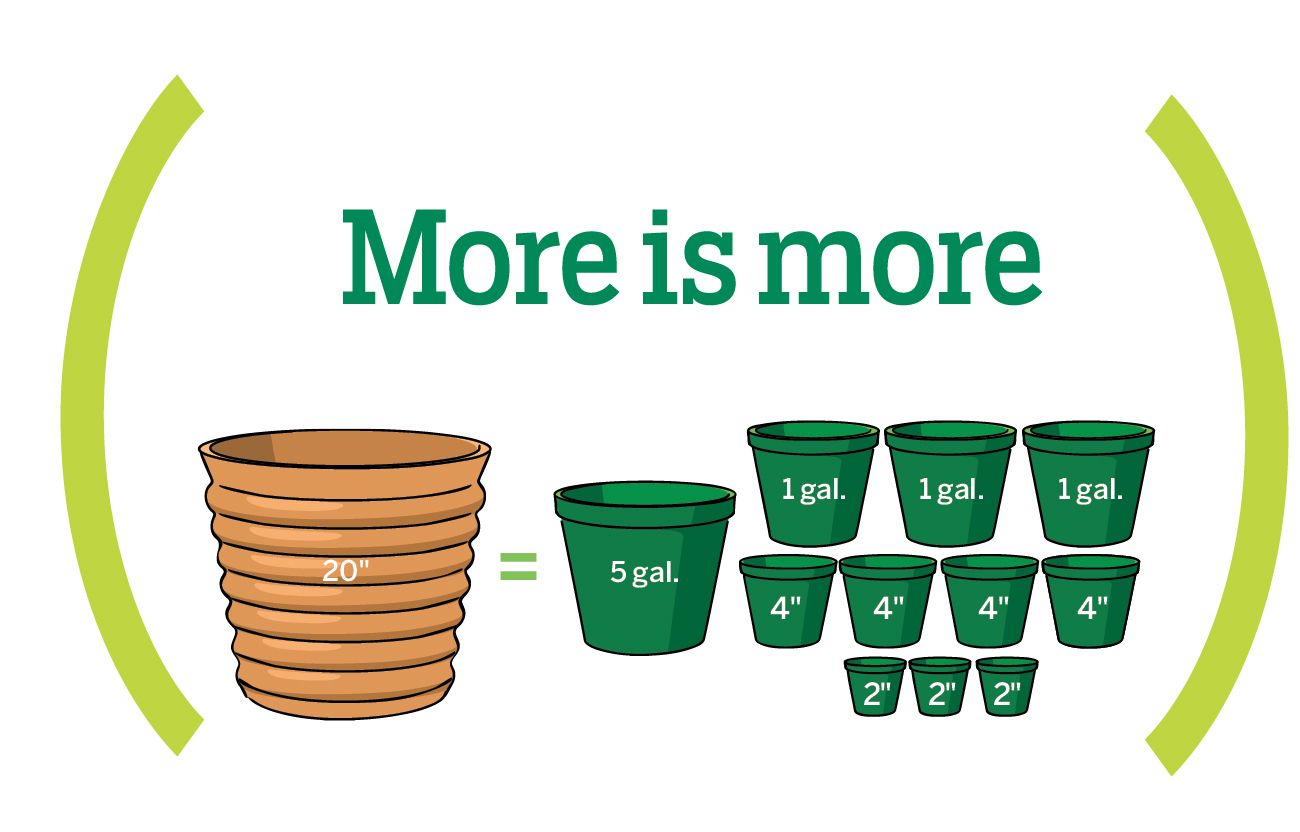
For an instantly full look, Karen Chapman fits a surprising number of plants into her designs right from the start. She prefers to use large, 20- to 30-inch-diameter containers, which she fills using the following formula of standard-size nursery pots. You can easily scale this back, however, when planting smaller containers.
